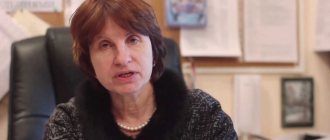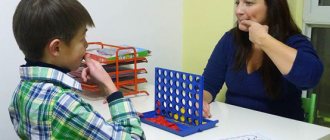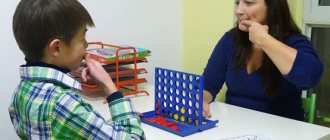The method of forming a language system (MFSL) for non-speaking children is used in working with various types of speech delay, such as: alalia, speech development disorder, stuttering, intellectual development disorders, Down syndrome, RDA. It was developed specifically for children with speech disorders of various natures, by Tamara Novikova-Ivantsova.
MFNP for non-speaking children reflects effective ways to solve the problem. These skills will be useful for both practicing speech therapists and beginning specialists. In addition, the material is presented in an accessible way for parents who want to conduct classes with their children on their own; this option will be an effective addition to the main therapy.
Early child development:
- Shichida method
It may seem that the complex is very simple, but in this case it is the consistency of the work that is important.
Goals and objectives
The author of this technique is the honored teacher of Russia and speech therapist with extensive experience T. N. Novikova-Ivantsova. The purpose of this manual is to teach children with severe speech impairments how to pronounce sounds, words, phrases and sentences. Recommendations are given for her work that will help not only experienced specialists, but also beginning teachers. Also, this manual is written in accessible language, which allows parents to work on it.
You will be interested in: CHIASSR: decoding of the abbreviation, population, districts and capital, history of collapse and restoration
The Novikova-Ivantsova technique is based on the following principles:
- it is necessary to create a favorable environment for speech development;
- You need to do practical speaking exercises regularly.
Your success with this manual depends on how systematically you follow these rules. After all, only constant training will help you achieve the desired result. It is necessary not only to “start” the child’s speech, but also to create an environment suitable for this.
You will be interested in: How to pass the OGE in biology: preparation, conditions for passing, advice from teachers
Factors influencing speech development
To successfully apply the Novikova-Ivantsova technique, you must create a comfortable speech environment for the child. The development of speech is influenced by the state of the child’s higher mental functions, i.e. he must have developed thinking, attention, memory and other cognitive processes. If any of these processes lags behind in development, then this also affects speech development.
Also, the child should move quite a lot. This improves blood circulation and brain function. Therefore, children with speech disorders are often recommended to go to the pool or do gymnastics. Also, in order to create a favorable speech environment, you must fulfill the following conditions:
- try to talk with your child on a variety of topics;
- use new words;
- your speech should be emotionally charged;
- you must pronounce words clearly and clearly;
- voice your actions;
- use visual material and speak out what you show.
One of the important nuances in working according to the Novikova-Ivantsova method is musical lessons. Listening and singing various songs (in your native language) have a beneficial effect on speech development. This helps to form the tempo-rhythmic side of speech and improve phonetic perception.
Review of the initial stages of work on starting speech in children with alalia. Methodology of Novikova-Ivantsova T.N.
Alalia is a severe underdevelopment or complete absence of speech caused by organic lesions of the cortical speech centers of the brain that occurred in utero or during the three years of a child’s life.
With alalia, there is a late appearance of speech reactions, a poor vocabulary, agrammatism, a violation of the syllabic structure, sound pronunciation and phonemic processes. Psychological, medical and pedagogical effects for alalia include drug therapy, the development of mental functions, lexico-grammatical and phonetic-phonemic processes, and coherent speech.
How to effectively help a child diagnosed with alalia?
There are few methodological developments on this problem, there is no specific clear system, so it is necessary to solve problems by combining various developments of modern speech therapists and psychologists. I propose to consider the interesting and productive work of speech therapist Tamara Nikiforovna Novikova-Ivantsova. The author of the development is a teacher of the Russian Federation, Candidate of Economic Sciences, speech therapist of the highest category, director of the State Budgetary Educational Institution “Special (correctional) primary school - kindergarten of the V type 1708 Moscow.” I present an overview of the initial stages of work on starting speech in children with alalia.
The uniqueness of this technique lies in the fact that it not only makes it possible to “launch the trigger” for the appearance of speech, but also helps in the work of a speech therapist with already speaking children in mastering the syllabic structure of a word, in normalizing the tempo-rhythmic aspect of speech, voice, in evoking and production of sounds, formation of phrasal speech. The author’s method of work is presented on the Internet in the form of excerpts from webinars for speech therapists, meetings between parents and the author, and short videos of practical classes.
The main core of the MFSL is reliance on the ontogenetic principle of speech development and the formation of language codes.
The beginning is to work with the prelinguistic level, with the basis of understanding and development of thought. Working on rhythm, tempo and intonation, or simply put, it’s working on babbling. A non-speaking child must first go through the stages of humming and babbling, that is, completely reproduce normal speech development, followed by its stages (reproduce speech ontogenesis).
It is also important to go through the stage of distinguishing non-speech sounds, and then smoothly move on to speech sounds, thereby forming a phonological code.
Main areas of work:
Development of the rhythmic-melodic-intonation side of speech (singing).
Evoking and clarifying the sounds of the Russian language
Development and correction of the syllable structure of a word
Development of the lexical and grammatical structure of speech
Development of phrasal speech.
Development of coherent speech.
On the speech therapist’s personal website you can find a description of the essence of the method, as well as a lot of practical material, Tamara Nikiforovna’s thoughts about speech therapy work. A very important aspect of developing speaking skills is the child’s immersion in the speech environment. You need to constantly communicate with him on various topics, look at book drawings and analyze what you see using words. Listening to songs in your native language helps a lot, especially when performed by your mother; this approach will help launch the speech mechanism. An interesting fact is that children to whom their mother sang as children often do not have problems with sound pronunciation.
Therefore, the key method of MFNS is music. In the process of restoring speech development, children sing vowels, which corresponds to the babbling stage, then pronounce syllables - this is the babbling stage, and then the result is consolidated with the help of two-syllable words and phrases. Development of rhythmic-melody-intonation organization of speech (RMIO) The formation of a rhythmic-intonation system according to the method is carried out using audio recordings of melodies specially selected for classes with children.
The preparatory stage includes techniques aimed at separating non-speech sounds and rhythmic exercises. The preparatory stage conditionally corresponds to the walking stage in ontogenesis. The initial stage involves evoking vowel sounds.
Objectives: to obtain a long voluntary oral exhalation with a long voluntary vocalization.
Novikova Ivantsova identifies three channels for obtaining information: tactile, visual, auditory.
Children with alalia cannot maintain visual attention for a long time, so in the work at the preparatory stage the emphasis is first on the tactile channel. This channel is completely saved.
In the practical part of the video lessons T.N. Novikova-Ivantsova shows ways of working posture between a speech therapist and a child.
The first is that the child is pressed with his back to the adult’s chest, the child’s legs are crossed “Turkish style”. The speech therapist holds his arms and legs with one hand, beating out a rhythm and rocking the child. The child feels vibration in his arms, legs, back, and chest. Vowel sounds and syllables are sung conjugately to music No. 1. Then the vowels are sung conjugate for a long time, then with a switch: “Aa-aa-aa, oo-oo-oo, uu-uu-uu.” Sometimes this system of singing leads to the involuntary formation of a syllable. At first, the child only gives a reaction while singing. The speech therapist needs to “play with the voice.” Only later does the child begin to sing monotonously, but this is already progress. Classes are energy-intensive, you need to do everything emotionally.
The speech therapist uses cards in classes - sound diagrams. Visual aids – cards are proposed to be attached to the speech therapist’s clothing so that the child can see them during individual work. Six symbols of vowel sounds (pictures by Maria Fedorovna Fomicheva). The figures have been slightly edited.
The second working position when working individually with a child is to make eye contact. The child is on the teacher’s lap, face to face. The speech therapist holds his hands like a crab, grasping the child’s hands. Beats the rhythm on the child’s knees one by one.
And the third solution is on the couch. The child lies, the speech therapist sits on the side, holding the child’s hand on his throat. With his right hand he corrects the child’s articulation and sings with the child. Be sure to sing conjugate first.
Work on singing sounds is carried out in the following sequence:
Singing one sound
Singing 2 sounds
Singing homogeneous syllable chains
Singing heterogeneous syllable chains
Singing words.
To the first melody, chants are sung, two-syllable words with the first stressed syllable are practiced: mom, dad, baba, porridge, vase, cotton wool.
STAGE 1
Goal: Formation of syllables. Develop the skill of smooth, rhythmic singing of syllables with changing vowels, changing consonants, closed syllables; smooth singing of onomatopoeias and words of 2 identical syllables.
Everyone sings in the same rhythm. You need to get voluntary breathing, voluntary vocalization, voluntary articulation.
Equipment. 2 options for syllable cards:
with a change in consonant sound (would, we, you...)
with a change in vowel sound (ba, bu, bi...) Moreover, whistling and hissing, sonorant sounds are introduced if they are present in the child’s speech.
Cards for “singing”: 4 pcs. for each onomatopoeia (with a change in the object near which the character is located).
STAGE 2
Goal: to develop the skill of smooth rhythmic singing of words of two syllables (of different structures) into two quarters with the first (second) stressed syllable and from 3 syllables.
Equipment: pictures with words and objects are collected in bags, in which there are two open, two closed syllables, etc. The pictures in bags on clamps are collected so that the words contain different consonants + one vowel. Different consonants and two vowels (for example: in all words O-U).
STAGE 3
Objectives: to develop the ability to smoothly switch while singing a phrase. Sing rhythmically on 2nd quarter and 3rd quarter. Learn to sing a phrase with any rhythmic contour.
Equipment: sheets with a list of verbs (with a specific syllable structure by grade) for the fine motor game “Funny Hands”. Hand movements help convey to speech pathologists the meaning (meaning) of words and actions. For example, I bake, wash, clean, eat. Because Children with motor alalia do not remember well what they have already done; before the skill is consolidated and the necessary connection is formed in the cerebral cortex, the child must repeat the same task many times.
These verbs accumulate over the years of training (verb sheets) and a subject vocabulary accumulates (see stage 2), from which a sentence is subsequently born (I see a llama, I see Masha, I see a fur coat...).
Chanted vowels, syllables, words, songs, an abundance of visual elements such as symbols and pictures - all this includes an effective technique of a practicing speech therapist. Methodical manuals “From Word to Phrase” have been published, where the material is conveniently selected, and the quality of the drawings is pleasing.
“Magic Buttons”, “Cheerful Hands”, “Locks” - these are just some of the techniques that Novikova-Ivantsova’s technique offers to master. These complexes allow you to simultaneously use visual memory and fine motor skills, thanks to which children quickly and easily master the syllabic structure of words. The methodology has a systematic approach, clear and specific instructions, and effectiveness. I think that MFNS will help modern speech therapists provide real help to non-speaking children.
Literature
1. Speech therapy: Textbook for students of defectology. fak. pedagogical universities /. Edited by L.S. Volkova, S.N. Shakhovskaya. M., 1998.
2. Novikova-Ivantsova T.N. From word to phrase. Book 2
/Methodological manual for the work of speech therapists on the formation of phrases in children with severe speech pathology/ Moscow, GOU 1708, 2010. - 38 p.
Stages of speech development
The Novikova-Ivantsova technique is built on the ontogenetic principle, i.e. it is based on the stages of speech formation. A child with normal speech development goes through all stages, but in non-speaking children this development is delayed. Therefore, before starting classes, you need to carry out diagnostics to determine at what stage you need to start working.
- A cry is the very first reflex speech reaction of a child. With its help, he communicates with the outside world. Normally it should be clear and clear. In children with speech development disorders, it is muted or absent at all.
- Humming is the utterance of vowel sounds, so adults think that the child is singing. Sometimes consonants are added to vowels. The baby is already trying to imitate the intonations of an adult; at this stage it is important to support his desire to communicate.
- Babbling is the repetition of a single syllable or word. Some parents mistake babbling for words. But this can be considered only when the child consciously uses it. After babbling, the child begins to speak in words.
By the age of one and a half, a child should have several words in his vocabulary from which he can make phrases. If a child had a delay at any stage, then, according to the Novikova-Ivantsova method, it needs to be worked out with the child. Thanks to this, the baby will be able to learn to put words together, then compose phrases and sentences.
Using touch spheres
At the very beginning of work using the method of Novikova-Ivantsova T.N. During classes, various sensory areas are used:
Particular emphasis in the work is placed on the tempo-rhythmic component and auditory perception. Therefore, the Novikova-Ivantsova method contains many tasks using music. This helps to form not only the articulatory apparatus, but also correct speech breathing.
“My first words” by N. A. Shishkina
This method of starting speech in non-speaking children is also based on the principles of developmental education and the unity of educational, training, development and correctional goals. The emergence and development of speech occurs as a result of the child’s various activities. First, the baby masters vowel sounds, and then adds consonants to them, the order of learning is from simple to complex.
To study each sound, you are given as much time as necessary in this particular case. The speech material of the technique was developed and tested by N. A. Shishkina over ten years. It is presented in the author's workbook “My First Words.” This manual is suitable for both children who more easily learn the sound characteristics of speech, and for children who are better able to understand the syllabic characteristics of speech.
It is recommended to start practicing according to Shishkina’s method from an early age.
How to work with a non-speaking child using Shishkina’s benefits? The first step is to elicit a vocal response to vowel sounds. Then it is important to teach the child to repeat words after an adult in the most convenient form for him; here the quality of pronunciation does not matter, since the main goal is to expand the vocabulary. N.A. Shishkina, who recommends adhering to the following rules:
- An adult’s speech should be emotional and consist of clear, specific instructions and explanations such as “show”, “hide”. It is advisable to accompany words with gestures and facial expressions, since for speechless children such “language” is most understandable.
- All actions are performed from left to right and from top to bottom, this subconsciously accustoms the child to reading and writing, albeit in the distant future.
- There are only six pictures on the sheet, which corresponds to the visual perception of a preschool child. The order of naming the pictures must be changed every lesson.
- The adult first completes each task himself, then either the child repeats the exercise independently or with the help of an adult.
Practicing each task consists of four exercises, which are called:
- “Picture-symbol” introduces the child to sound and helps create a play situation;
- “Magic Buttons”, an exercise aimed at eliciting a vocal response. Multi-colored square buttons are “pressed” with the index finger, and the sound is pronounced only once;
- "Soundtracks". Here the child needs to attach the sticker to the desired square. Then, running his finger along the path, the child pronounces the syllable.
- “Say the words with the sounds you are learning.” The adult selects the desired sticker, reads the word, then asks the child to place the sticker where it should be, name the sound and circle the corresponding letter with a pencil.
On average, you need to use two stickers per practiced sound per lesson. Gradually the tasks become more difficult.
Stages of speech therapy work
The Novikova-Ivantsova technique—“speech evocation”—is aimed at helping children with severe disabilities master phrasal speech. Speech therapy work includes several stages.
For speech therapy assistance to be effective, consistency must be observed and classes must be regular.
Features of the technique
There are various techniques that are aimed at helping non-speaking children. What makes Novikova-Ivantsova’s work stand out?
It is these features that distinguish the Novikova-Ivantsova technique.
These are our favorite Happy Hands verbs.
Goal: work on semantics through the definition of frequency action verbs. It is verbs, thanks to their ability to attract words, that give a phrase like “Lala is running.”
45 verbs are given with a precise description of the exercises performed in conjunction or reflected with the corresponding MOVEMENTS for certain parts of the arms: shoulder, forearm, hand, etc. to rhythms of two quarters with the first and second stressed syllables such as saw, cut, dig, see, blow, etc.
Calendar-thematic planning contains material for 36 lessons with a child. These are 36 technological maps, in fact these are detailed, verified notes of 36 lessons.
You receive a full program of work at the preparatory stage, conduct each lesson with your child at least three times, for a total of 100 lessons with one child.
All this speech therapy gold IS SO FAR FOR ONLY 700 RUBLES.
results
Quite often, speech therapists use the Novikova-Ivantsova technique to work with non-speaking children. And many admire the results achieved, noting the progress of children with alalia. But some of the disadvantages note that you need to do only “singing” for several months, so not all children and parents like such activities. Others include tasks they like in their classes. But the main thing is to maintain consistency and take into account all the features of this technique.
Classes based on Novikova-Ivantsova’s manual are an opportunity for children with severe speech impairments to learn to communicate with people. This technique takes into account the ontogenesis of speech, which allows for the most effective construction of speech therapy work.
Source
Methodology of Tatyana Gruzinova
Game speech therapy, developed by T. V. Gruzinova, is based on a systematic approach to speech as a complex mechanism. If during the diagnosis a child is revealed to have insufficient development of certain functions, the speech therapist “increases” them or forms speech in conditions of their deficiency, if due to organic pathologies it is impossible to compensate for them. The emphasis is on developing the child’s motivation and using everything possible in this case “basics”: gestures, music, rhythm, etc.
Playful speech therapy is suitable for children with various types of alalia, general speech underdevelopment, epilepsy, autism spectrum disorders, and Down syndrome.
The launch of speech occurs in three stages:
- First, the speech therapist evokes and reinforces the involuntary consonant sounds that appear in a non-speaking child when he is emotionally involved in play. The speech therapist develops stable associations in the child based on the movement of an object and a gesture, pushing him to consciously pronounce the sound. Each sound corresponds to a specific gesture and toy. Then the speech therapist forms the remaining consonants by “blowing” air through the barrier formed by the child’s speech organs and reinforces them in the game.
- The essence of the second stage is that the speech therapist guides the child to the end of the word according to the principle of adding a stressed syllable to an unstressed syllable. Thus, the structure of the word is obtained in a given rhythm. Then the child masters words of several syllables.
- At the final stage, the baby learns to pronounce phrases, supporting them with gestures, pictures, objects and working on their rhythm and melody.
The most important thing, according to T.V. Gruzinova, is to establish a positive emotional contact between the speech therapist and the child, to find a motive that is important for the child, which everyone has. With the help of ABA therapy and an interview with parents, the play speech therapist selects the set of “basics” that the child speaks relatively well, and, relying on them, guides the child to sound speech. Classes are held in a comfortable environment for children, for example, sitting on the floor on a play mat, and have a play form that is close to the child. Whatever method you choose, be patient. Initiating speech in non-speaking children is a very slow process that requires painstaking collaboration between parents, child and speech therapist.







